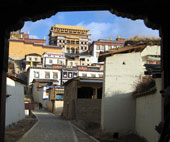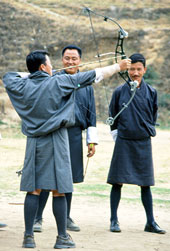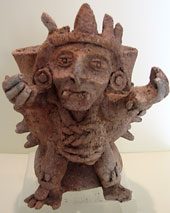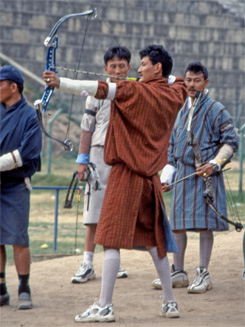
Dancing about and shouting sexual insults at the opposing team, Bhutanese sports fans enjoy their favorite pastime—archery!
Archery? It may seem counter intuitive for a devoutly Buddhist nation to choose a sport like archery since Buddhists have a profound reverence for all living things. Participating in a sport where the equipment is primarily designed for hunting or warfare seems a bit out of place. However, judging by the fact that nearly all villages in the Kingdom of Bhutan have an archery range, passion for the sport is not to be taken lightly.
Popularity of the sport can be traced all the way back to a 15th century legend. During this time, it is believed Lama Drukpa Kuenley, known affectionately as the “divine madman,” shot an arrow from Nangkartse in Tibet. Following the path of the arrow led him to Bhutan, land of the thunder dragon. Archery symbolism is present in Buddhist beliefs and often represents the offering of prayers.
Today the matches are a festival of brightly-costumed archers and spectators alike. In fact, the activity is centered as much around the pageantry of the festival as it is around the competition of hitting the bulls-eye. Archers go to great lengths to distract or demoralize their opponents—even going so far as to dance in front of the other’s target! This behavior is not just limited to the archers—the women in the crowd act as cheerleaders, shouting raucous and degrading comments about the other team’s heritage and sexual prowess. All of the hullabaloo is in jest, and no one is ruffled by it or takes much offense.
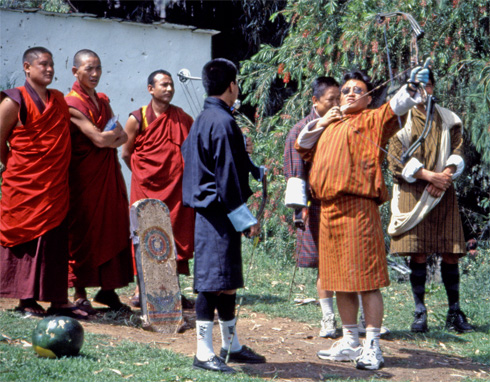
Wielding the traditional hand-carved bamboo bow (nowadays some use state-of-the-art compound bows), participants compete in teams of 15 players. Two points are given if the arrow hits any part of the target, three points for a bullseye, and if the arrow sticks in the ground within one arrow’s distance of the target, the team earns one point. The first team to score 25 points is declared the winner. To play, the archers are each given two shots during their turn. The field is set up like a horseshoe pitch, so team members shuttle between the targets in between shots. Not only is hitting the target difficult, but the walking back and forth across the pitch can be tiresome as well, because the small wooden targets are placed 140 meters apart! That’s nearly three times the distance of Olympic standards (a mere 50 meters) and probably why archers take the risk of taunting their rivals while standing in front of the target. The rival discouragement is a large part of the spectacle.
Archery is the only Olympic sport in which Bhutanese athletes compete. The Bhutanese have been involved in the games since 1984 and in the 2004 Olympics they made it to the second qualifying round. In the 2012 London Olympics, Bhutan sent two female archers, one of the smallest teams at the event. They remain hopeful that Olympic gold is in their future. For now, as in the past, the bowmen (and women!) from Bhutan continue to play for the love of the sport and the next chance to poke fun at their friends.

